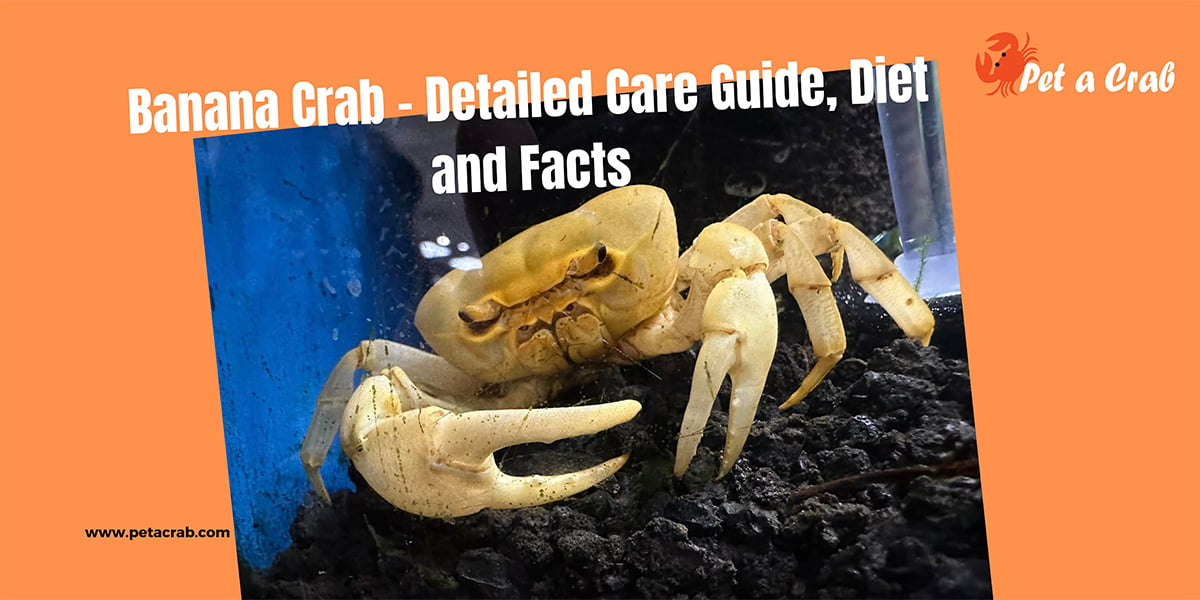The banana crab; a mysterious crab that keeps us confused with its identification and color. You will get lost over Google trying to find exact info about them.

The banana crab is a very playful pet and easy to care for. But they die after a few days as the owners don’t know the right care and other requirements for them. But don’t worry here I gathered all the information you need to know to keep the banana crab in the paludarium.

Quick overview of the banana crab
| Name | Mangrove crab, Banana crab, Gold crab |
| Distribution and habitat | Borneo, MalaysiaJava, Indonesia |
| Scientific name | Terrathelphusa mas |
| Care Level | Easy |
| Size | 3.5 to 8 cm (1.5 to 3+ inches) |
| Lifespan | 3 to 5 years in captivity |
| Optimal temperature | 22-30°C (72 to 85°F) |
| Temperament | Semi agressive |
| Breeding | No record was found in captivity |
| Diet | Omnivore |
| Sleeping nature | Nocturnal |
| Color | Golden yellow |
| Humidity | 70% to 80% |
Banana crab facts
- Rainy Daytime - The semi semi terrestrial crab like the banana crab comes out during the day during heavy rain. Otherwise, they like to burrow and hide during the day being nocturnal. Also, they are active during the day without rain.
- Appearance - The banana crab has a smooth carapace, golden yellow skin, and a broad and swollen shell. The families are very big but small compared to the males and the male’s claws are bigger and stronger. The name banana crab comes from their yellow appearance resembling the banana color and can reach up to 3.2 cm in size.
- Naming - You can find their nature and appearance in the naming. The word “terra” means land, “thelphusa” means semi-terrestrial, and mas means gold.
The banana crab is also referred to as the banana fiddler crab (Austruca mjoebergi) and the banana vampire crab (Geosesarma tricolour).
How to take care of your banana crab
Tank setup
The type of tank they’ll need is called a freshwater paludarium, where the crab gets access to both land and water; which resembles their wild habitat best.
Chose the tank
Choose a 10 to 15-gallon tank for 1-2 crabs it is a type of crab that needs enough space to play and climb.
If you plan to keep it with other animals, the tank needs to be bigger and cover the tank with a lid. Consider a 20-gallon tank for a small group. As they’re territorial having a bigger paludarium is crucial. In the case of overcrowded tanks, they will get aggressive.

Right substrate
Use sand as a substrate with a mix of gravel, and ensure the grains are small so that the crab doesn’t need much effort to pick them. Also, they burrow under the substrate so there is a possibility they get stuck if the stones are bigger.
Pour substrate deeply at least 8-9 inches deep, minimum twice as deep as their size keeping a section for water. This crab is well-known for burrowing up to 3 ft deep. So, the deeper the substrate the more likely they get their wild vibe.
The water area should comprise 20% to 40% of the entire surface area. Keep the water height below the crab’s height so that the crab can come out any time as it’s not a fully aquatic crab.
Decoration
Place plenty of rocks and caves along with woods, this will help them hide and climb. If you have more than one crab plenty of hiding places are required as all crabs will claim their territory.
Be creative with the hiding places setting; there are many products like pipe half logs, clay pots, or castle cribs you can find on Amazon.
The plant is not necessary for the banana crab but if you like you can go for typical terrarium plants or setting up a terrarium with a wide open substrate and water can be a good option.
Caution - The roots of the plants can spread through the substrate which can cause problems for the crab’s digging, avoid plants like snake plants as it is toxic, consuming this may kill the banana crab.

Temperature, water, and light requirements for the banana crab
There is a lot of flexibility in temperature with this crab. They can adapt to room temperature from 22-30°C but 23 to 29°C will be a safe range. With a thermometer, ensure the temperature is in this range.
They’re freshwater crabs; so no saltwater or brackish water is required for them but the water should be dechlorinated with a pH level of 7.0 - 8.5.
Set up aquarium lights resembling the day and nighttime to bring out their natural (nocturnal) behavior ensuring the right color.
Semi terrestrial crabs like the banana crabs and the vampire crabs have modified gills that help them breathe air. The gills always need to be moistened, that’s why they need high humidity and water accessibility.
Feeding of the banana crab
95% of the crabs are omnivorous, so as the banana crab, meaning they will eat whatever they get edible. So there is no limitation in feeding.
You can start with fish flakes and pallets, then you can go for mysis and brine shrimp or other meaty food like blood worms and small insects. Wet cat food can be a good option though.
Feed fruits and vegetables daily; for example - broccoli, kale, spinach, apple strawberries, and bananas. These should be served in small pieces; they may not like to eat the fresh fruits, instead, they’ll let the food rot and then eat. No problem with them as long as rotten food doesn’t spoil the habitat and doesn’t bring mites.
Avoid any kind of dairy foods, uncooked potatoes, citrus fruits, salty foods, spicy and sugary foods. As the banana crabs’ stomachs can’t tolerate them. Observe their eating pattern and see what they don’t like and feed accordingly.
Ensure they get balanced food with a lot of calcium which will help them while molting and growing new strong exoskeleton quickly. For calcium feed them with crushed eggshells and cuttlebone.


